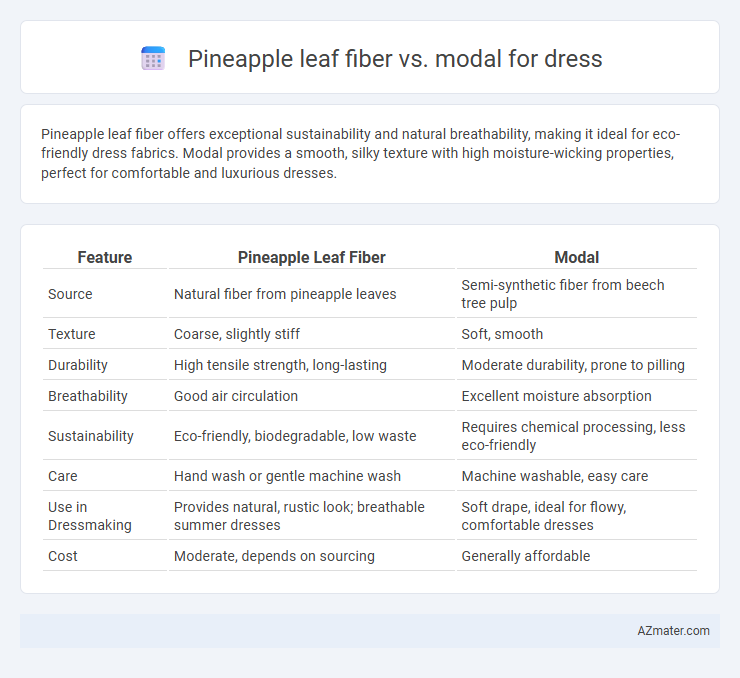Pineapple leaf fiber offers exceptional sustainability and natural breathability, making it ideal for eco-friendly dress fabrics. Modal provides a smooth, silky texture with high moisture-wicking properties, perfect for comfortable and luxurious dresses.
Table of Comparison
| Feature | Pineapple Leaf Fiber | Modal |
|---|---|---|
| Source | Natural fiber from pineapple leaves | Semi-synthetic fiber from beech tree pulp |
| Texture | Coarse, slightly stiff | Soft, smooth |
| Durability | High tensile strength, long-lasting | Moderate durability, prone to pilling |
| Breathability | Good air circulation | Excellent moisture absorption |
| Sustainability | Eco-friendly, biodegradable, low waste | Requires chemical processing, less eco-friendly |
| Care | Hand wash or gentle machine wash | Machine washable, easy care |
| Use in Dressmaking | Provides natural, rustic look; breathable summer dresses | Soft drape, ideal for flowy, comfortable dresses |
| Cost | Moderate, depends on sourcing | Generally affordable |
Introduction to Pineapple Leaf Fiber and Modal
Pineapple leaf fiber is a sustainable, natural textile derived from the leaves of the pineapple plant, known for its strength, breathability, and eco-friendly characteristics. Modal, a semi-synthetic fabric made from beech tree cellulose, offers exceptional softness, moisture-wicking abilities, and a smooth, luxurious texture ideal for dress materials. Comparing pineapple leaf fiber and modal highlights the contrast between natural durability and softness, with pineapple leaf fiber excelling in sustainability and modal providing enhanced comfort and drape.
Origins and Production Processes
Pineapple leaf fiber, derived from the leaves of the Ananas comosus plant, is produced through a manual extraction process involving decortication and retting, which separates the fibers for textile use, making it a sustainable and eco-friendly choice. Modal, a semi-synthetic fiber originating from beech tree cellulose, undergoes a chemical-intensive process where cellulose is dissolved and regenerated into fibers, offering a soft, breathable fabric ideal for dresses. The production of pineapple leaf fiber emphasizes natural, biodegradable materials with low environmental impact, while modal relies on industrial processes with controlled chemical treatments for consistent fiber quality.
Environmental Impact and Sustainability
Pineapple leaf fiber is a natural, biodegradable material derived from agricultural waste, offering a low-impact alternative with minimal water and chemical usage compared to Modal, which is a chemically processed, semi-synthetic fabric made from beech wood pulp. Modal production often involves energy-intensive processes and potential chemical pollution, whereas pineapple leaf fiber supports circular economy principles by utilizing plant by-products that would otherwise go to waste. The sustainability credentials of pineapple leaf fiber include reduced carbon footprint and enhanced biodegradability, making it a more eco-friendly choice for dress fabrics.
Texture and Comfort Comparison
Pineapple leaf fiber offers a coarse and textured feel, providing natural breathability but a slightly rougher touch compared to Modal. Modal fabric delivers a smooth, silky texture with excellent softness, enhancing overall comfort for dresswear. While pineapple leaf fiber is eco-friendly and durable, Modal excels in fluid drape and moisture-wicking properties, making it preferable for sensitive skin.
Breathability and Moisture Management
Pineapple leaf fiber offers excellent breathability due to its natural porous structure, allowing air to flow freely and keeping the wearer cool in warm conditions. This sustainable fiber excels in moisture management by absorbing sweat efficiently and drying quickly, reducing discomfort from dampness. Modal, while soft and smooth, provides moderate breathability but tends to retain moisture longer than pineapple leaf fiber, making the latter a superior choice for dresses requiring enhanced ventilation and moisture-wicking properties.
Strength and Durability Factors
Pineapple leaf fiber offers exceptional strength and durability due to its long, stiff fibers, making it highly resistant to wear and tear in dress fabrics. Modal, a semi-synthetic fiber derived from beech trees, provides softness and flexibility but tends to have lower tensile strength and can wear out faster compared to pineapple leaf fiber. For dress materials requiring long-lasting durability and structural integrity, pineapple leaf fiber outperforms modal in maintaining strength through repeated use and washing.
Aesthetic Qualities and Versatility
Pineapple leaf fiber offers a natural, textured aesthetic with a subtle sheen that enhances the rustic and eco-friendly appeal of dresses, while Modal delivers a smooth, silky finish that drapes elegantly for a sophisticated look. Pineapple fiber's stiffness provides structure ideal for statement pieces, whereas Modal's lightweight and breathable nature allows for versatile styles ranging from casual wear to formal attire. Both fibers support sustainability, but Modal's superior color retention and wrinkle resistance make it highly adaptable for diverse fashion designs.
Cost and Market Availability
Pineapple leaf fiber is an eco-friendly natural textile derived from pineapple plant leaves, offering a sustainable alternative to traditional fabrics but often comes with higher production costs due to limited processing infrastructure. Modal, a semi-synthetic fabric made from beech tree pulp, is widely available and generally more cost-effective, benefiting from established manufacturing and global distribution networks. Market availability for pineapple leaf fiber remains niche and less consistent, while modal enjoys broad accessibility in the dressmaking industry due to its softness and affordability.
Care and Maintenance Tips
Pineapple leaf fiber dress fabric requires gentle hand washing with mild detergent and air drying to preserve its natural texture and strength. Modal fabric, known for its softness and durability, allows machine washing on a gentle cycle with cold water and low heat drying, reducing the risk of shrinkage and color fading. Both fabrics benefit from avoiding bleach and ironing on low settings to maintain their quality and longevity.
Which Is Better for Dresses?
Pineapple leaf fiber offers exceptional sustainability and breathability, making it ideal for eco-conscious dressmakers seeking natural fabrics with a unique texture. Modal, a semi-synthetic fiber derived from beech wood pulp, provides superior softness, drape, and moisture-wicking properties that enhance comfort and fit in dresses. For durable, lightweight, and smooth garments, Modal excels, while pineapple leaf fiber stands out for its biodegradable strength and environmental benefits.

Infographic: Pineapple leaf fiber vs Modal for Dress
 azmater.com
azmater.com